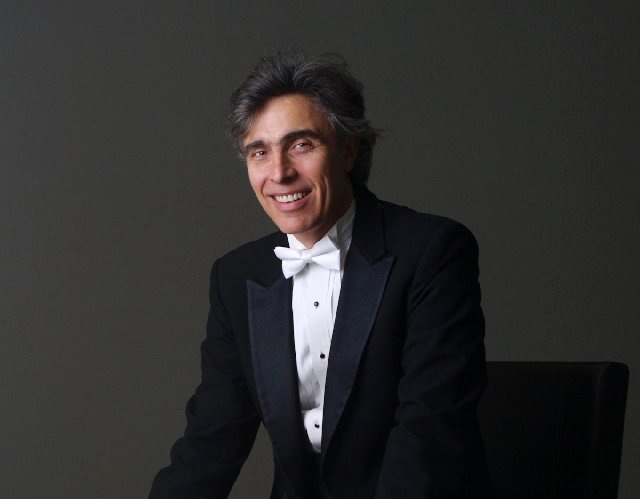Philharmonic soars with ‘The Planets’
At a Las Vegas Philharmonic concert, it’s the sound that counts.
But you can attach an asterisk to that statement when it comes to Saturday’s season finale in The Smith Center’s Reynolds Hall.
That’s because sight joins sound in the spotlight for the “Celestial Bodies” concert — at least while the Philharmonic plays Gustav Holst’s “The Planets.”
In addition to hearing Holst’s perennially popular orchestral suite, Reynolds Hall audiences will see high-definition images of outer space synchronized to the music.
“The Planets: An HD Odyssey” was created by documentary filmmaker Duncan Copp and commissioned by the Houston Symphony.
Considering Houston’s link with the National Aeronautics and Space Administration, Houston Symphony officials “had the glorious idea” to invite U.S. astronauts to a performance of “The Planets,” music director Hans Graf recalls in a promotional video for the HD release.
The astronauts were “taken away by the sheer sound of the orchestra,” Graf notes. But they were less than captivated by the “old and dusty” outer space footage featured at the concert.
Instead, they suggested the symphony seek out high-definition images from various exploratory missions.
Made in cooperation with NASA and Jet Propulsion Laboratories, “The Planets: An HD Odyssey” has been performed not only by the Houston Symphony (in New York’s Carnegie Hall and in Europe) but by other orchestras as well.
And on Saturday, the Las Vegas Philharmonic joins the list.
Although guest conductor David Lockington has conducted “The Planets” many times — and has conducted live orchestral accompaniment of other movies — Saturday’s concert will be a first for him combining the two, he says during a telephone interview.
(Recently appointed music director of the Pasadena Symphony — he holds the same post with symphonies in Modesto, Calif., and Grand Rapids, Mich. — Lockington is the latest candidate in the Philharmonic’s ongoing search for a new music director, which will continue into a second season.)
“I’ve done performances of movies, where the conductor is frantically trying to coordinate second-to-second” synchronization of music and image, and “it’s very stressful,” he says. “This is not quite the same way.”
Lockington plans to “put my head down” and lead the Philharmonic, figuring “if we just play the music, the images will take care of themselves.”
In this case, pairing sight and sound offers “a different experience, a different journey” for listeners, he suggests, comparing to the difference between a recording and a live performance. “Once in a while, the taste of it is really intoxicating and quite exciting.”
Then again, audiences have found “The Planets” intoxicating and exciting ever since its 1916 debut.
Holst composed the seven-movement suite between 1914 and 1916, inspired by astrolabes — and the astrological significance of such planets as “Mars, the Bringer of War,” “Venus, the Bringer of Peace,” “Mercury, the Winged Messenger,” “Jupiter, the Bringer of Jollity,” “Saturn, the Bringer of Old Age” (reportedly Holst’s favorite) and “Uranus, the Magician.”
The suite’s finale — “Neptune, the Mystic” — includes one of the first orchestral uses of a fade-out ending, as an offstage women’s chorus (Saturday’s concert features the women of the Las Vegas Master Singers, directed by Jocelyn Jensen ) repeats the final bar of the piece “until the sound is lost in the distance,” as the composer stipulated.
Such was (and is) “The Planets’ ” popularity that “Holst almost regretted writing it,” Lockington says, because it overshadowed other works he considered musically superior.
Regardless of Holst’s view, it remains one of Lockington’s “favorite pieces,” along with the two other “Masterworks” that round out Saturday’s program: Wolfgang Amadeus Mozart’s Symphony No. 31 in D major (also known as the “Paris Symphony”) and Richard Wagner’s Prelude and Liebestod from “Tristan und Isolde .”
The Mozart symphony achieves “such energy and elegance,” says Lockington, who’s conducted it “maybe a handful of times.” Mozart composed it in 1778, “when he was traveling — and trying to get a job.” (Unsuccessfully.)
Wagner’s “Tristan und Isolde,” meanwhile, qualifies as “one of the most influential operas of all time,” the conductor says.
Among the reasons why: Wagner’s advanced use of tonality, harmony and polyphony. His innovations began with the opera’s opening chord, now known as the “Tristan” chord, which was considered daring — and disorienting — when first heard in 1865.
Almost 150 years later, the very same notes can still transport audiences.
“Orchestral music is an incredibly plastic medium,” Lockington says. “It’s constantly changing, shifting. Each generation finds its own relationship to this great music. It’s rather a fun part of the business.”
Contact reporter Carol Cling at ccling@
reviewjournal.com or 702-383-0272.
Preview
Las Vegas Philharmonic
8 p.m. May 4 (pre-concert talk at 7:15 p.m.)
Reynolds Hall, The Smith Center for the Performing Arts, 361 Symphony Park Ave.
$46-$94 (702-749-2000, www.thesmithcenter.com)






















